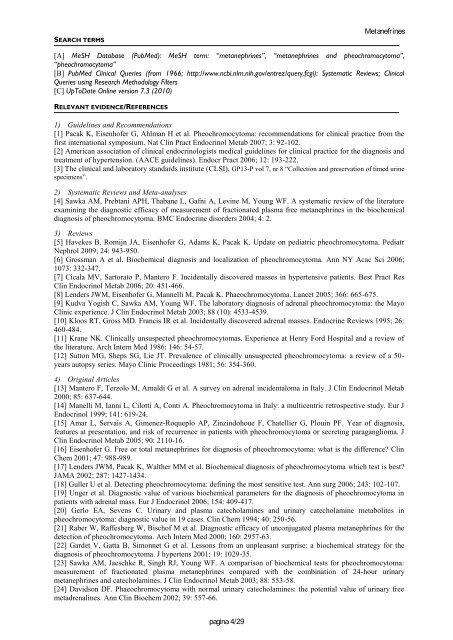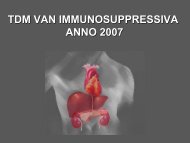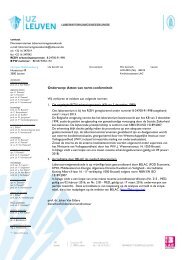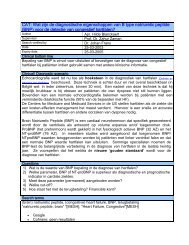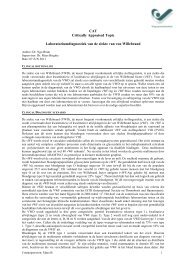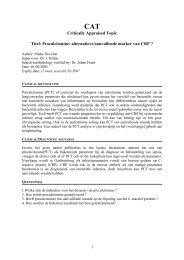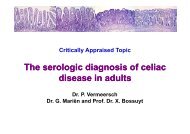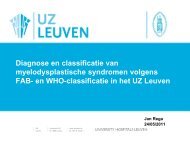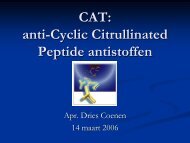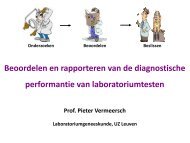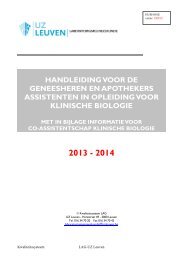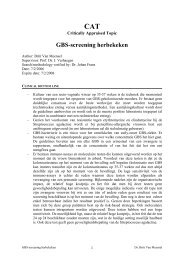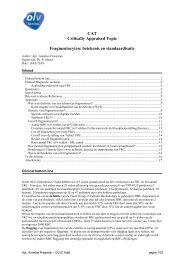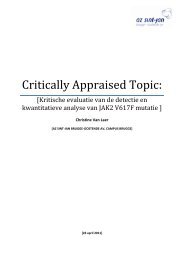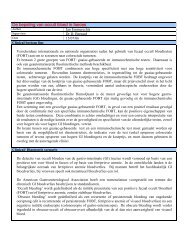SEARCH TERMSMetanefrines[A] MeSH Database (PubMed): MeSH term: “metanephrines”, “metanephrines and pheochromocytoma”,“pheochromocytoma”[B] PubMed Clinical Queries (from 1966; http://www.ncbi.nlm.nih.gov/entrez/query.fcgi): Systematic Reviews; ClinicalQueries using Research Methodology Filters[C] UpToDate Online version 7.3 (2010)RELEVANT EVIDENCE/REFERENCES1) Guidelines and Recommendations[1] Pacak K, Eisenhofer G, Ahlman H et al. Pheochromocytoma: recommendations for clinical practice from thefirst international symposium. Nat Clin Pract Endocrinol Metab 2007; 3: 92-102.[2] American association of clinical endocrinologists medical guidelines for clinical practice for the diagnosis andtreatment of hypertension. (AACE guidelines). Endocr Pract 2006; 12: 193-222.[3] The clinical and laboratory standards institute (CLSI), GP13-P vol 7, nr 8 “Collection and preservation of timed urinespecimens”.2) Systematic Reviews and Meta-analyses[4] Sawka AM, Prebtani APH, Thabane L, Gafni A, Levine M, Young WF. A systematic review of the literatureexamining the diagnostic efficacy of measurement of fractionated plasma free metanephrines in the biochemicaldiagnosis of pheochromocytoma. BMC Endocrine disorders 2004; 4: 2.3) Reviews[5] Havekes B, Romijn JA, Eisenhofer G, Adams K, Pacak K. Update on pediatric pheochromocytoma. PediatrNephrol 2009; 24: 943-950.[6] Grossman A et al. Biochemical diagnosis and localization of pheochromocytoma. Ann NY Acac Sci 2006;1073: 332-347.[7] Cicala MV, Sartorato P, Mantero F. Incidentally discovered masses in hypertensive patients. Best Pract ResClin Endocrinol Metab 2006; 20: 451-466.[8] Lenders JWM, Eisenhofer G, Mannelli M, Pacak K. Phaeochromocytoma. Lancet 2005; 366: 665-675.[9] Kudva Yogish C, Sawka AM, Young WF. The laboratory diagnosis of adrenal pheochromocytoma: the MayoClinic experience. J Clin Endocrinol Metab 2003; 88 (10): 4533-4539.[10] Kloos RT, Gross MD. Francis IR et al. Incidentally discovered adrenal masses. Endocrine Reviews 1995; 26:460-484.[11] Krane NK. Clinically unsuspected pheochromocytomas. Experience at Henry Ford Hospital and a review ofthe literature. Arch Intern Med 1986; 146: 54-57.[12] Sutton MG, Sheps SG, Lie JT. Prevalence of clinically unsuspected pheochromocytoma: a review of a 50-years autopsy series. Mayo Clinic Proceedings 1981; 56: 354-360.4) Original Articles[13] Mantero F, Terzolo M, Arnaldi G et al. A survey on adrenal incidentaloma in Italy. J Clin Endocrinol Metab2000; 85: 637-644.[14] Manelli M, Ianni L, Cilotti A, Conti A. Pheochromocytoma in Italy: a multicentric retrospective study. Eur JEndocrinol 1999; 141: 619-24.[15] Amar L, Servais A, Gimenez-Roqueplo AP, Zinzindohoue F, Chatellier G, Plouin PF. Year of diagnosis,features at presentation, and risk of recurrence in patients with pheochromocytoma or secreting paraganglioma. JClin Endocrinol Metab 2005; 90: 2110-16.[16] Eisenhofer G. Free or total metanephrines for diagnosis of pheochromocytoma: what is the difference? ClinChem 2001; 47: 988-989.[17] Lenders JWM, Pacak K, Walther MM et al. Biochemical diagnosis of pheochromocytoma which test is best?JAMA 2002; 287: 1427-1434.[18] Guller U et al. Detecting pheochromocytoma: defining the most sensitive test. Ann surg 2006; 243: 102-107.[19] Unger et al. Diagnostic value of various biochemical parameters for the diagnosis of pheochromocytoma inpatients with adrenal mass. Eur J Endocrinol 2006; 154: 409-417.[20] Gerlo EA, Sevens C. Urinary and plasma catecholamines and urinary catecholamine metabolites inpheochromocytoma: diagnostic value in 19 cases. Clin Chem 1994; 40: 250-56.[21] Raber W, Raffesberg W, Bischof M et al. Diagnostic efficacy of unconjugated plasma metanephrines for thedetection of pheochromocytoma. Arch Intern Med 2000; 160: 2957-63.[22] Gardet V, Gatta B, Simonnet G et al. Lessons from an unpleasant surprise: a biochemical strategy for thediagnosis of pheochromocytoma. J hypertens 2001; 19: 1029-35.[23] Sawka AM, Jaeschke R, Singh RJ, Young WF. A comparison of biochemical tests for pheochromocytoma:measurement of fractionated plasma metanephrines compared with the combination of 24-hour urinarymetanephrines and catecholamines. J Clin Endocrinol Metab 2003; 88: 553-58.[24] Davidson DF. Phaeochromocytoma with normal urinary catecholamines: the potential value of urinary freemetadrenalines. Ann Clin Biochem 2002; 39: 557-66.pagina 4/29
Metanefrines[25] Perry CG, Sawka AM, Singh R, Thabane L, Bajnarek J, Young WF. The diagnostic efficacy of urinaryfractionated metanephines measured by tandem mass spectrometry in detection of pheochromocytoma. ClinEndocrinol 2007; 66: 703-8.[26] Eisenhofer GE, Sullivan P, Csako G. Pheochromocytoma. Improving diagnosis with plasma freemetanephrines. Clin Lab News Feb 2001: 6-8.[27] Peaston RT, Neely RDG. Biochemical diagnosis of pheochromocytoma: the role of plasma metanephrines.Proceedings of the first international symposium of pheochromocytoma. 2005 [abstract 150].[28] Bravo EL, Bravo T. Clinical characteristics of incidentally discovered pheochromocytoma from an analysis of50 proven cases. Proceedings of the first international symposium of pheochromocytoma. 2005 [abstract 27].[29] Singh RJ. Advances in metanephrine testing for the diagnosis of pheochromocytoma. Clin Lab Med 2004;24:85.[30] Pacak K. et al. Recent advances in genetics, diagnosis, localization and treatment of pheochromacytoma. AnnIntern Med 2001; 134: 315-329.[31] Weise M, Merke DP, Pacak K, Walther MM, Eisenhofer G. Utility of plasma free metanephrines fordetecting childhood pheochromocytoma. J Clin Endocrinol Metab 2002; 87: 1955-1960[32] Zelinka T, Eisenhofer G, Pacak K. Pheochromocytoma as a catecholamine producing tumor: implications forclinical practice. Stress 2007; 10: 195-203.[33] Davidson DF. Elevated urinary dopamine in adults and children. Ann Clin Biochem 2005; 42: 200-207.[34] Eisenhofer et al. Biochemical and clinical manifestations of dopamine-producing paragangliomas: utility ofplasma methoxytyramine. J Clin Endocrinol Metab 2005; 90-2068-2075.[35] Eisenhofer G, Goldstein DS, Walther MM et al. Biochemical diagnosis of pheochromocytoma: how todistinguish true- from false-positive test results. J Clin Endocrinol Metab 2003; 88: 2656-66.[36] Lenders JWM, Willemse JJ, Eisenhofer G, Ross HA, Pacak K, Timmers JLM, Sweep CGJ. Is supine restnecessary before blood sampling for plasma metanephrines? Clin Chem 2007; 53: 352-354.[37] De Jong WHA, Eisenhofer G, Post WJ, Muskiet FAJ, de Vries EGE, Kemo IP. Dietary influences on plasmaand urinary metanephrines: implications for diagnosis of catecholamine-producing tumors. J Clin EndocrinolMetab 2009; 94 2841-2849.[38] De Jong WHA, Eisenhofer G, Post WJ, Muskiet FAJ, de Vries EGE, Kema IP. Dietary influences on plasmaand urinary metanephrines: implications for diagnosis of catecholamine-producing tumors. J Clin EndocrinolMetab 2009; 94: 2841-2849.[39] Willemsen JJ, Sweep CGJ, Lenders JWM, Ross HA. Stability of plasma free metanephrines during collectionand storage as assessed by an optimized HPLC method with electrochemical detection. Clin Chem 2003; 49:1951-3.[40] Giles HG, Meggiorini S. Stability of catecholamines in urine. Clin Chem 1983; 29: 595.[41] Lee ZSK, Critchley JAJH. Simultaneous measurement of catecholamines and kallikrein in urine using boricacid preservative. Clin Chim Acta 1998; 276: 89-102.[42] Miki K, Sudo A. Effect of urine pH, storage time, and temperature on stability of catecholamines, cortisol andcreatinine. Clin Chem 1998; 44: 1759-62.[43] Weinkove C. Measurement of catecholamines ad their metabolites in urine. J Clin Pathol 1991; 44: 269-75.[44] Elfering A, Grebner S, Semmer NK, Byland C, Gerber H. Two urinary catecholamine measurement indicesfor applied stress research: effects of time and temperature until freezing. Hum Factors 2003; 45: 563-74.[45] Iu YP, Ho CS, Mak TWL. Formate buffer as preservative for urinary free catecholamine measurent. Ann ClinBiochem 2004; 41: 39-42.[46] Gouarne C, Foury A, Duclos M. Critical study of common conditions of storage of glucocorticoids andcatecholamines in 24h urine collected during resting and exercising conditions. Clin Chim Acta 2004; 348: 207-14[47] Boomsma F, Alberts G, van Eijk L, Man in „t Veld AJ, Schalekamp MA. Optimal collection and storageconditions for catecholamine measurements in human plasma and urine. Clin Chem 1993; 39: 2503-8.[48] Chan ECY; Wee PY, Ho PC. Evaluation of degradation of urinary catecholamines and metanephrines anddeconjugation of their sulfoconjugates using stability-indicating reversed-phase ion-pair HPLC withelectrochemical detection. J Pharm Biomed Anal 2000; 22: 515-26.[49] Willemsen JJ, Ross HA, Lenders JWM, Sweep FCGJ. Stability of urinary fractionated metanephrines andcatecholamines during collection, shipment and storage of samples. Clin Chem 2007; 268-272.[50] Sawka AM, Gafni A, Thabane L, Young WF. The economic implications o three biochemical screeningalgorithms for pheochromocytoma. J Clin Endocrinol Metab 2004; 89: 2859-2866.[51] Eisenhofer G, Walther M, Keiser HR, Lenders JWM, Friberg,Pacak K. Plasma metanephrines: a novel andcost-effective test for pheochromocytoma. Braz J Med Biol Res 2000; 33: 1157-1169.5) Reference Works, Handbooks and Databases[52] Tietz textbook of clinical chemistry and molecular diagnostics. 4 de editie 2006. Burtis CA, Ashwood ER,Bruns DA. Elsevier Saunders.[53] Interpretation of Diagnostic tests. 8 ste editie 2007. Wallach J, MD. Wolters Kluwer. Lippincott Williams &Wilkins.6) “grey literature”[54] ARUP Laboratories, nationaal klinisch en anatoom-pathologisch referentielabo, Universiteit Utah endepartement pathologie.pagina 5/29


